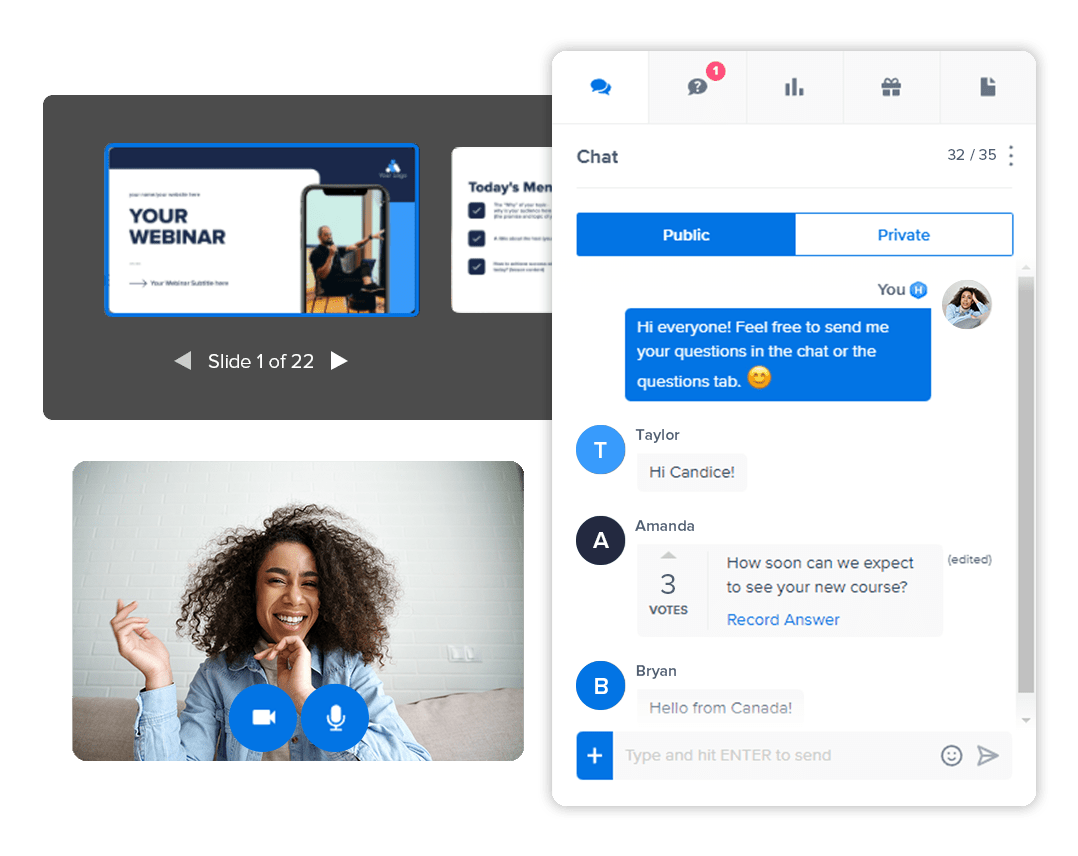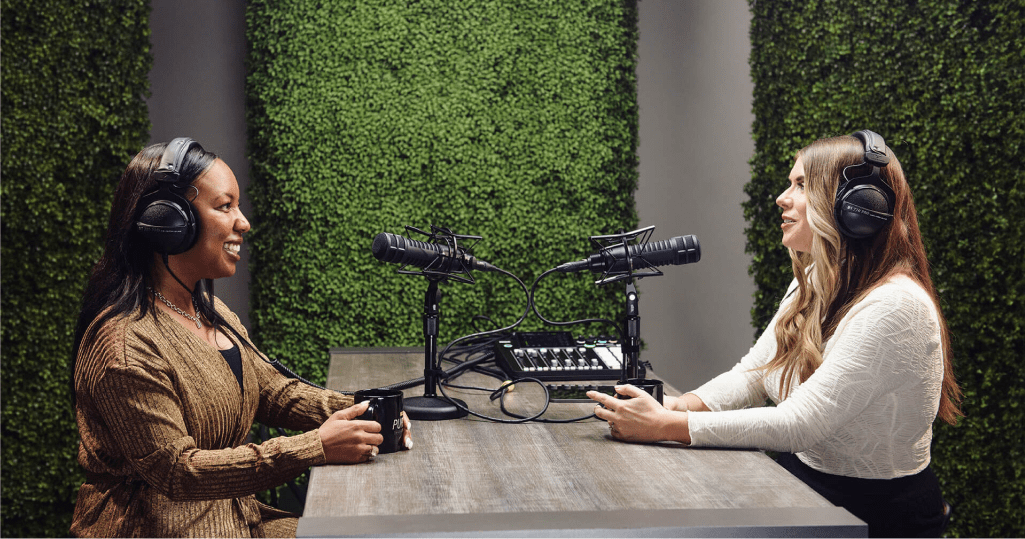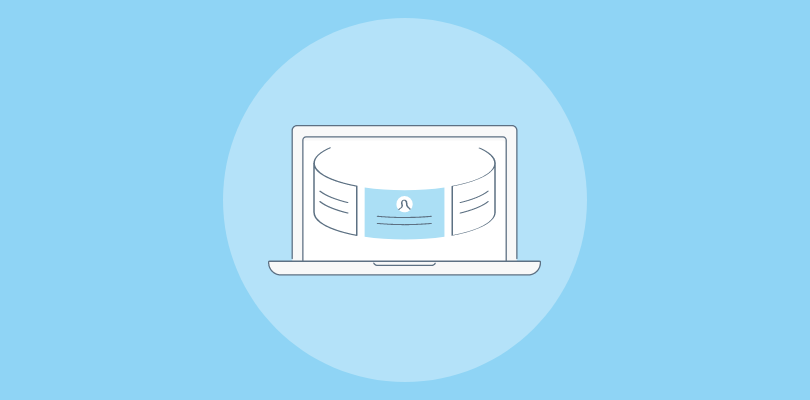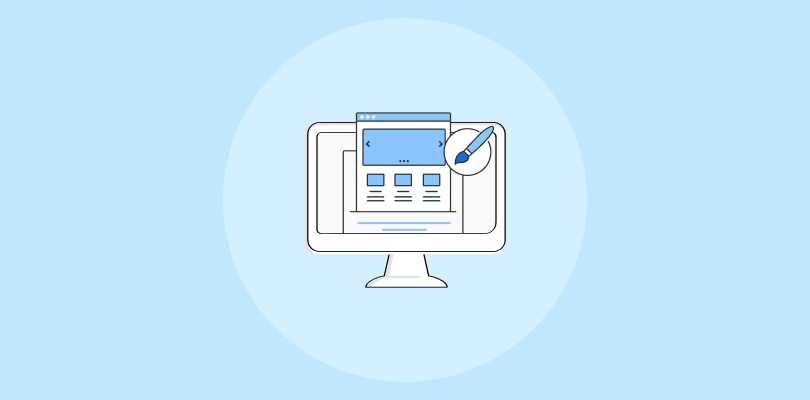“Roses are red, violets are blue,
webinars are visual, and podcasts…
well, they’re just audio, aren’t they?”
Not so fast!
When I first started in the webinar world, I assumed they were just podcasts with visuals added in. But after nearly a decade in the webinar industry, I’ve learned there’s way more to these digital formats than meets the eye (or ear).
So, if you’re still caught up in the webinar vs. podcast debate, here’s a guide that will help you understand the key features, benefits, similarities, and differences so that you can choose the right one for your needs.
Let’s dive in.
Webinars: Key Features and Benefits
Key Features of Webinars
- Ease of Setup and Hosting: Modern webinar solutions streamline the process of creating, managing, and hosting webinars, making them accessible even for those without technical expertise.
- Interactive Elements: Webinars come equipped with features like live Q&A, polls, and chat functions that allow for real-time audience engagement and participation.
- Automated and Live Options: Both live and pre-recorded webinars can be utilized, offering flexibility for hosts and ensuring content reaches audiences at their convenience.
- Seamless Marketing Integration: Many webinar platforms include tools for email marketing, reminders, and registration forms, simplifying outreach and audience engagement efforts.
- Detailed Analytics: Post-webinar insights, including attendance reports and engagement metrics, allow for precise audience understanding and strategy refinement.
- Customizable Branding: Webinars allow for customization, ensuring that registration pages, interfaces, and emails align with the organization’s brand identity.
- HD Video and Audio Quality: High-quality streaming capabilities provide a professional and immersive experience for attendees, reflecting well on the host.
- Record and Replay Features: Sessions can be recorded for on-demand viewing, ensuring content remains accessible for those unable to attend live or for future use.
- Support for Multiple Webinar Types: Options for live, automated, series, or hybrid webinars provide versatility to meet different needs and goals.
- Wide Accessibility: Webinars eliminate geographical barriers, allowing anyone with an internet connection to participate.
Benefits of Webinars
- Improved Accessibility: Webinars enable participants from across the globe to join without the constraints of travel, making it easier to reach a diverse audience.
- Enhanced Engagement: Features like live polling, Q&A, and chat foster meaningful interactions, keeping the audience actively involved and attentive throughout the session.
- Time Flexibility: Automated webinars allow hosts to deliver content without the need to be present live, making it easier to reach audiences in different time zones.
- Stronger Lead Generation: By capturing attendee information during registration, webinars act as a powerful tool for collecting and nurturing leads, turning them into potential customers.
- Efficient Marketing: Built-in promotional tools like email campaigns and reminders streamline the process of attracting attendees and maximizing participation.
- Data-Driven Decisions: Detailed reports and analytics provide insights into attendee behavior, allowing for the continuous improvement of content and strategies to meet audience needs better.
- Cost Savings: Webinars significantly reduce the expenses associated with traditional events, such as travel, venue, and accommodation costs, making them highly cost-effective.
- Versatility of Content: Recorded sessions can be repurposed for training, marketing, or educational resources, ensuring the content continues to deliver value.
- Brand Authority and Trust: Hosting well-organized webinars on specific topics positions organizations or individuals as experts in their field, enhancing credibility and trust.
- Environmental Impact: Webinars are eco-friendly, reducing the need for physical venues, printed materials, and travel, contributing to sustainability goals.
Podcasts: Key Features and Benefits
Key Features of Podcasts
- On-Demand Accessibility: Podcasts are available anytime, allowing listeners to choose when and where to tune in, making them highly convenient for audiences with busy schedules.
- Wide Variety of Formats: Podcasts come in various styles, such as interviews, solo episodes, panel discussions, or storytelling, catering to diverse audience preferences.
- Multi-Platform Availability: Podcasts are distributed on multiple platforms, including Spotify, Apple Podcasts, and Google Podcasts, ensuring broad accessibility.
- Audio-Centric Content: With a focus on audio, podcasts allow listeners to consume content without visual distractions, making them ideal for multitasking.
- Subscription and Notification Features: Listeners can subscribe to their favorite podcasts and receive updates whenever new episodes are released, fostering regular engagement.
- Cost-Effective Production: Compared to other forms of media, podcasts are relatively inexpensive to produce, requiring minimal equipment and resources.
- Niche-Specific Content: Podcasts often target specific interests or industries, allowing creators to connect deeply with niche audiences.
- Scalability: Podcasts can grow organically through word-of-mouth and reviews, reaching broader audiences over time without significant additional investment.
- Custom Branding Opportunities: Creators can incorporate unique intro music, logos, and consistent themes to establish a recognizable brand identity.
- Guest Collaboration: Podcasts often feature guest speakers, enabling cross-promotion and offering listeners fresh perspectives and insights.
Benefits of Podcasts
- Flexibility for Listeners: Podcasts allow audiences to listen during activities like commuting, exercising, or working, integrating seamlessly into daily routines.
- Engaging Storytelling: The audio format fosters an intimate connection with listeners, making it an excellent medium for storytelling and personal narratives.
- Building Authority: Consistently publishing valuable content positions podcast hosts as thought leaders and trusted voices within their niche or industry.
- Expanding Reach: With distribution across global platforms, podcasts can reach audiences worldwide, transcending geographical barriers.
- Audience Loyalty: Podcasts cultivate a loyal audience base as listeners develop a connection with hosts over time, fostering trust and ongoing engagement.
- Monetization Opportunities: Creators can generate revenue through sponsorships, advertisements, merchandise, and subscription models, turning podcasts into profitable ventures.
- Low Barrier to Entry: Podcasts are easy to start, requiring basic equipment and software, making them accessible to individuals and small businesses.
- Educational and Informative: Podcasts provide an engaging way to learn about new topics, skills, or industries, making them a popular medium for professional development and entertainment.
- Community Building: Podcasts often foster a sense of community among listeners, encouraging discussion and interaction through social media and listener feedback.
- Eco-Friendly Media Option: Podcasts consume less energy than video content and do not require physical materials, making them an eco-friendly option.
What Are the Similarities Between Webinars & Podcasts?
While podcast vs. webinar is always debatable, and they differ in delivery and interaction levels, they share several fundamental similarities, too. Here are some of the similarities between them:
- Reach Audiences Online
Both webinars and podcasts are digital formats, making them accessible to anyone with an internet connection. They remove geographical barriers, allowing creators to engage with a global audience.
- Leverage Audio as a Key Medium
Both formats rely on audio as a core element for content delivery. While webinars may include visuals, audio remains crucial for conveying messages, much like podcasts.
- Educate and Inform Effectively
Webinars and podcasts focus on delivering valuable content, whether through expert discussions, interviews, or deep dives into specific topics. They are designed to inform, educate, or entertain their listeners or viewers.
- Provide Flexible Access
Both can be experienced live or as recordings, giving audiences the flexibility to engage with the content on their own schedules. This on-demand accessibility is a major draw for modern consumers.
- Support Recurring Series
Webinars and podcasts often follow an episodic structure, enabling creators to build ongoing series that maintain audience interest over time. Each episode typically focuses on a particular theme or subject.
- Lower Barriers to Entry
Both formats are relatively easy to produce with basic equipment and software, making them accessible to individuals and organizations alike for creating and sharing content.
Webinar vs Podcast: Key Differences
Now that we have seen the similarities, it’s time to discover the webinar and podcast differences, and these are tabulated below:
| Aspect | Webinar | Podcast |
|---|---|---|
| Definition | A webinar is an interactive, live, or pre-recorded online event that typically involves visual presentations and audience engagement. | A podcast is a pre-recorded audio (and sometimes video) series available on-demand for streaming or download. |
| Format | Webinars often include video content, slide presentations, live demonstrations, and a host or panel of speakers interacting with the audience. | Podcasts are generally audio-only but may include video. They consist of one or more hosts discussing topics or conducting interviews. |
| Interactivity | Webinars are highly interactive, allowing attendees to ask questions, participate in polls, or engage in live chat. | Podcasts are non-interactive as they are pre-recorded, and audience feedback is typically gathered separately, such as via social media. |
| Real-Time Availability | Webinars are typically conducted live and at a scheduled time, requiring real-time attendance. Recordings are mostly available after the event. | Podcasts are asynchronous, allowing listeners to tune in conveniently without time constraints. |
| Audience Engagement | Webinars often aim to engage an audience in real-time through Q&A sessions, chat features, and live polls. | Podcasts are primarily a one-way communication medium, with engagement occurring post-listening, such as through reviews or comments. |
| Purpose | Webinars are usually educational or promotional, aiming to train, inform, or convert participants, often focusing on direct engagement. | Podcasts focus on storytelling, entertainment, education, or building a loyal listener base over time. |
| Duration | Webinars are longer, typically lasting 30 minutes to 2 hours, depending on the topic and depth of interaction. | Podcasts are shorter, usually ranging from 10 to 60 minutes, catering to on-the-go consumption. |
| Technology Required | Webinars require robust live streaming platforms such as WebinarNinja and Zoom and often require advanced setup, including cameras and microphones. | Podcasts require recording and editing software, such as Audacity or Adobe Audition, and distribution platforms like Spotify or Apple Podcasts. |
| Monetization | Webinars are often monetized directly through ticket sales, registrations, or product sales during the session. | Podcasts are monetized via sponsorships, advertisements, or subscription-based access models over time. |
| Accessibility | Webinars usually require registration, specific webinar software, and attendance at a specific time. | Podcasts are available on multiple platforms for free or subscription-based listening anytime, anywhere. |
Podcast vs. Webinar: When to Choose One
So, after we saw the differences between the webinar and podcast, it’s time to unveil each of their usage strategies. Let’s start with webinars:
When to Choose a Webinar
Webinars are typically a great choice when you need live, interactive engagement with your audience. They are perfect for real-time communication and complex subjects that benefit from visual aids and audience participation.
1. Real-time Interaction and Q&A
If you want to engage with your audience directly, webinars allow for real-time interaction. They’re ideal when you need to answer questions on the spot, get feedback, or host live polls.
Example:
If you’re hosting a product demo or live tutorial on a new software feature, a webinar would be a great platform. The audience can ask questions in real-time, and you can address them immediately, making the experience more engaging.
2. Complex Topics with Visual Aids
For topics that require visual explanations, like technical demonstrations, training sessions, or detailed product walkthroughs, a webinar can effectively showcase your content. Presentations, screen sharing, and visual aids help communicate complicated concepts in a digestible way.
Example:
A tech company launching a new product might use a webinar to walk potential customers through the product’s features, showing them step-by-step how to use the product.
3. Building Relationships and Networking
If you’re looking to build a stronger relationship with your audience, webinars offer a more personalized approach. You can host networking sessions, direct communication with key stakeholders, and smaller breakout rooms to enhance connection.
Example:
A B2B SaaS company might host a webinar where they bring in industry experts to discuss current trends. Participants can network with the experts and peers during a Q&A session or breakout discussions.

4. Time-Sensitive Events and Announcements
Webinars are great for time-sensitive content. When you have limited-time offers or need to build excitement around an upcoming event, webinars can provide an immediacy that podcasts cannot.
Example:
If you’re launching a new product, hosting a live webinar can create a sense of urgency and excitement, encouraging the audience to act fast.
When to Choose a Podcast
Podcasts are a better fit for on-demand content that doesn’t require real-time interaction. They’re great for storytelling, providing insights, and reaching an audience who prefers to consume content during commutes or downtime.
1. Accessibility and Flexibility for Listeners
Podcasts are perfect if your audience is busy or on the go. They can be listened to anytime and anywhere. People often listen to podcasts while commuting, exercising, or multitasking.
Example:
If you’re running a marketing podcast, you can have guests like industry experts talk about the latest trends. People can listen while driving, making it easier to reach them during their day-to-day activities.
2. Storytelling or Educational Content
Podcasts are fantastic for content that’s more narrative in nature or requires in-depth exploration over a longer period. They allow the host to build stories or explore topics at their own pace without the need for visual aids.
Example:
A true crime podcast series works well because it draws listeners in with episodic storytelling. Similarly, a career advice podcast can offer valuable tips over multiple episodes, keeping listeners engaged over time.

(Image Source: Purdue University)
3. Long-Form Discussions and Interviews
Podcasts lend themselves well to interviews and long-form discussions where you can dive deep into a subject without worrying about time limits. If the content you’re producing requires nuance or you’re having detailed interviews with multiple guests, a podcast allows for a relaxed, unstructured flow.
Example:
An entrepreneurship podcast could feature interviews with successful business owners discussing their challenges. This format gives you time to explore their journey thoroughly without worrying about strict schedules or presentation formats.
4. Creating a Consistent, On-Demand Content Series
Podcasts are ideal for creating a content series that listeners can follow over time. Once a listener subscribes to your podcast, they can receive regular updates and access to older episodes at their leisure.
Example:
A fitness coach might create a podcast with weekly episodes focusing on different aspects of health and fitness. The episodes can build on each other, creating a loyal audience who keeps coming back for more.
5. Reach a Wider, Passive Audience
If your goal is to create content that doesn’t necessarily require active participation but can build a loyal, long-term audience, podcasts are great. They can reach a wider demographic, especially those who prefer passive content consumption.
Example:
A news podcast allows listeners to stay updated on world events without needing to tune into a live broadcast or webinar.
Webinar vs. Podcast: What’s Your Pick?
When choosing between a webinar and a podcast, it’s all about what you want to get out of it.
If you’re aiming for real-time connection, live feedback, and a more interactive vibe, webinars are your best bet. You can chat with your audience, answer their questions, and get them involved with polls or Q&A. Podcasts are great when you want to reach people anytime, anywhere—perfect for those on the go who like to listen while commuting or working out.
And here’s the thing—having the right tool like WebinarNinja can make a huge difference if you choose webinars. With features like live chat, polls, and easy follow-up, it makes running smooth and engaging webinars quite easy.
Want to host a webinar for free?
Use WebinarNinja to teach, improve marketing, and grow your sales.







